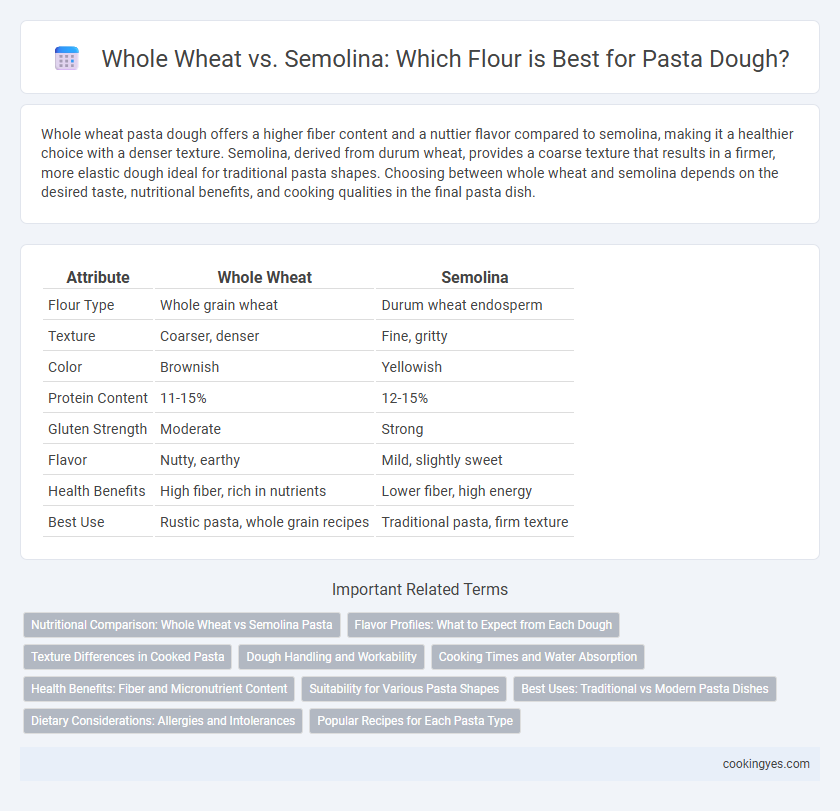Whole wheat pasta dough offers a higher fiber content and a nuttier flavor compared to semolina, making it a healthier choice with a denser texture. Semolina, derived from durum wheat, provides a coarse texture that results in a firmer, more elastic dough ideal for traditional pasta shapes. Choosing between whole wheat and semolina depends on the desired taste, nutritional benefits, and cooking qualities in the final pasta dish.
Table of Comparison
| Attribute | Whole Wheat | Semolina |
|---|---|---|
| Flour Type | Whole grain wheat | Durum wheat endosperm |
| Texture | Coarser, denser | Fine, gritty |
| Color | Brownish | Yellowish |
| Protein Content | 11-15% | 12-15% |
| Gluten Strength | Moderate | Strong |
| Flavor | Nutty, earthy | Mild, slightly sweet |
| Health Benefits | High fiber, rich in nutrients | Lower fiber, high energy |
| Best Use | Rustic pasta, whole grain recipes | Traditional pasta, firm texture |
Nutritional Comparison: Whole Wheat vs Semolina Pasta
Whole wheat pasta offers higher fiber content, more vitamins like B-complex, and greater mineral density compared to semolina pasta, which is primarily rich in gluten and provides a more refined carbohydrate source. Semolina pasta has a lower glycemic index than regular white pasta but falls short of whole wheat in antioxidant levels and dietary fiber. Choosing whole wheat pasta supports better digestive health and sustained energy release due to its complex nutrient profile.
Flavor Profiles: What to Expect from Each Dough
Whole wheat pasta dough offers a nutty, earthy flavor with a slightly denser texture due to the bran and germ content. Semolina pasta dough provides a more neutral, mildly sweet taste with a firm, chewy bite that enhances traditional Italian recipes. Choosing between them depends on whether you prefer a robust, wholesome flavor or a classic, mild pasta base.
Texture Differences in Cooked Pasta
Whole wheat pasta dough produces a denser and chewier texture due to its higher fiber content and bran particles, resulting in a more robust bite after cooking. Semolina pasta, made from durum wheat, has a smoother, firmer texture with a slight graininess that holds shape well through boiling. The gluten quality in semolina lends elasticity and a tender yet resilient mouthfeel, distinguishing it from the coarser whole wheat variety.
Dough Handling and Workability
Whole wheat pasta dough tends to be denser and less elastic due to its higher fiber content, making it slightly more challenging to knead and shape compared to semolina dough. Semolina flour, derived from durum wheat, provides a coarser texture and higher gluten strength, resulting in dough that is more pliable and easier to work with for rolling and cutting. The increased elasticity of semolina dough supports better extrusion and shaping, contributing to pasta with a firm yet tender bite.
Cooking Times and Water Absorption
Whole wheat pasta dough typically requires longer cooking times due to its higher fiber content, which slows water absorption compared to semolina. Semolina pasta dough absorbs water more quickly, resulting in shorter cooking times and a firmer texture. Understanding these differences helps achieve optimal pasta consistency and texture during preparation.
Health Benefits: Fiber and Micronutrient Content
Whole wheat pasta dough contains higher fiber levels and essential micronutrients such as magnesium, iron, and B vitamins, supporting digestive health and energy metabolism. Semolina pasta dough provides a moderate amount of protein and is rich in selenium, an antioxidant that promotes immune function. Choosing whole wheat over semolina enhances dietary fiber intake and boosts key micronutrient consumption, contributing to better overall health outcomes.
Suitability for Various Pasta Shapes
Whole wheat flour, rich in fiber and nutrients, offers a denser texture ideal for robust pasta shapes like fusilli and rigatoni that hold sauces well. Semolina, derived from durum wheat, provides a coarse, granular texture yielding a firm, elastic dough perfect for classic shapes such as spaghetti and macaroni that require a smooth, resilient bite. The choice between whole wheat and semolina influences dough elasticity, cooking time, and ultimately the pasta's ability to complement different sauce types and textures.
Best Uses: Traditional vs Modern Pasta Dishes
Whole wheat flour offers a denser texture and nuttier flavor ideal for rustic, traditional pasta dishes like pappardelle or tagliatelle that pair well with hearty sauces. Semolina flour, derived from durum wheat, provides a coarse, gritty texture with excellent elasticity, perfect for classic Italian recipes such as spaghetti or penne ensuring a firm bite and smooth finish. Modern pasta variations often blend whole wheat and semolina to balance nutrition and texture, creating versatile doughs suitable for both innovative fillings and contemporary sauce pairings.
Dietary Considerations: Allergies and Intolerances
Whole wheat pasta dough contains higher fiber and essential nutrients but may trigger gluten intolerance or celiac disease symptoms, as it includes the entire wheat kernel, including the bran and germ. Semolina, derived from durum wheat, offers a fine texture and distinct flavor but also contains gluten, making it unsuitable for individuals with wheat allergies or gluten sensitivity. Choosing between whole wheat and semolina pasta dough requires careful consideration of specific dietary restrictions related to gluten and wheat protein allergies.
Popular Recipes for Each Pasta Type
Whole wheat pasta dough, rich in fiber and nutrients, is commonly used in hearty recipes like vegetable-loaded primavera or rustic tomato-based sauces that complement its robust texture. Semolina pasta dough, prized for its fine, golden quality and firm bite, is the foundation for traditional Italian recipes such as classic spaghetti carbonara and delicate ravioli fillings. Popular dishes highlight whole wheat's wholesome depth, while semolina-based pastas excel in recipes requiring elasticity and a smooth finish.
Whole wheat vs Semolina for pasta dough Infographic

 cookingyes.com
cookingyes.com